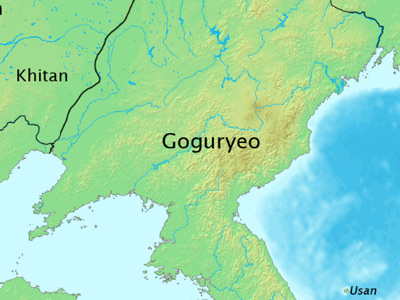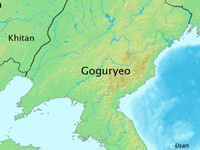Goguryeo–Sui War (598-614 AD)

The Goguryeo–Sui War were a series of invasions launched by the Sui dynasty of China against Goguryeo, one of the Three Kingdoms of Korea, between AD 598 and AD 614. It resulted in the defeat of the Sui and was one of the pivotal factors in the collapse of the dynasty, which led to its overthrow by the Tang dynasty in AD 618.
Background
The Sui Dynasty united China in AD 589, defeating the Chen Dynasty and ending the division of the country that spanned almost 300 years. After the unification of China, Sui asserted its position as an overlord of neighbouring countries. However, in Goguryeo, one of the Three Kingdoms of Korea, Pyeongwon and his successor Yeongyang insisted on maintaining an equal relationship with the Sui Dynasty.
Wendi of Sui was displeased with the challenge from Goguryeo, which continued small scale raiding into Sui's northern border. Wendi sent diplomatic papers in 596 after Sui envoys spotted Goguryeo diplomats in the yurt of the Eastern Turk Khanate, demanding Goguryeo cancel any military alliance with the Turks, stop the annual raiding of Sui border regions, and acknowledge Sui as their overlord. After receiving this message, Yeongyang launched a joint preemptive invasion with the Malgal against the Chinese along the border in present-day Hebei province; It was the following year, 597.
Course of the war
First Invasion of 598
Wendi ordered his fifth and youngest son, Yang Liang (assisted by the co-prime minister Gao Jiong), and Admiral Zhou Luohou, to invade and conquer Goguryeo with an army and navy totaling 300,000, mostly composed of archer cavalry.
Yang Liang's army faced the early rainy season when it reached Goguryeo. The unseasonably heavy rain made the army's progress almost impossible and hampered the transport of provisions. Constant attacks by Goguryeo forces and illness inflicted heavy casualties. Coming to the conclusion that the army could not achieve the objective on its own, Yang decided to combine with Zhou's naval fleet and proceed.
Zhou's navy also came across their own challenges, contending with rough seas, losing many ships despite staying close to the coastline. Whenever they anchored, Goguryeo detachments were present to attack the Sui sailors, and Sui fleet suffered a devastating loss.
Second Invasion of 612
Yangdi, when he won the throne in 604, built the Grand Canal connecting the north and south of China. The south, economic base of China, and the north, political base of China, were connected by the canal, allowing transportation of troops for the massive military campaign.
After the construction of the canal, Yangdi ordered the enlisting of soldiers in 611. He instructed them to gather in present-day Beijing. The force gathered by year's end was one of the greatest in civilization according to the Book of Sui, which states that 1,133,000 troops were mobilized and that the support troops multiple times that number. The army began to depart in early 612, and due to its size, it took 40 days for all of them to depart. The long line of soldiers stretched for about 300 kilometers. However, the strength and losses may have been deflated by later Chinese historians to discredit the Koreans; Additionally maintaining the dignity of China, which they believed was the creator of culture, order, and civilization.
Yeongyang gave up the buffer zone that he had acquired after the war of 598, as the area was not suitable to face such a vast army. The Goguryeo troops retreated behind what is now known as the Liao River. A fortunate event for Goguryeo was that the river melted much sooner than usual. By the time Yangdi arrived, the ice had all melted. Undaunted, Yangdi ordered the construction of three bridges across the river. The bridges however, were too short to reach the opposite bank in another fortunate turn of events for the defenders, and Goguryeo's ambush successfully held off the first assault. After the extension of the bridges however, the Sui forces succeeded in crossing the river, and the army surrounded the fortresses of Goguryeo.
Yangdi ordered his generals before the campaigns not to make individual decisions regarding the movement of troops, but to report to him to receive instruction. This order hampered Sui strategy throughout the campaign. During the strategically important campaign against Yodong fortress, the general commanding the siege had to send a messenger to the emperor for the approval of the surrender. By the time the messenger returned, Goguryeo's troops were again ready to defend the fortress. Exploiting this flaw in the Sui system, Yodong and other castles of Goguryeo continued to hold on. By June, five months after the start of the campaign, not a single castle, fortress, or citadel has fallen to Sui. Yangdi felt that a fundamental change in strategy was needed to seize control of Korea.
The new strategy was to keep the fortresses of Goguryeo in Manchuria at bay, while sending a contingent of army and navy to take Pyongyang, Goguryeo's capital. An army contingent, allegedly with a strength of 305,000, and a naval fleet of some 200,000 were dispatched.
The Goguryeo navy reached the bay of the Daedong River before the army. Seeing that the Sui army had not arrived yet, Yeongyang sent a small host to engage the Sui navy in battle. After a short engagement, feigning defeat, Goguryeo troops retreated into the city. The Sui naval commander, Lai Huni, considering this was a chance to add to his merit, led a host of more than 100,000 to lay assault against Pyeongyang.
When the Sui soldiers reached one of the outer castles, however, they found the wall empty and the gate open. Upon entering the castle, they found the valuables and weapons laid out in the open. Being cautious, Lai Huni didn't allow looting. While passing through a large Buddhist temple, Goguryeo troops ambushed Sui troops, but it failed and survivors retreated yet again. Lai, considering the ambush in the temple a decisive move of Goguryeo that failed, looted and destroyed the art and fortune of the outer castle.
While the looting of the castle was at its peak, special contingent of Goguryeo troops, consisting of thousands of troops, ambushed the Sui troops. Confused and disoriented, Lai didn't offer resistance, but ran to the fleet at the sea, his legion reduced to mere thousands. Disheartened by his failure, Lai changed his plan to wait for the army contingent to move against Pyeongyang and combine to lay siege on the city.
Sui army's campaign
The army contingent, led by generals Yu Zhongwen and Yuwen Shu, had their own problems. While the supply could be transported safely within China, once it reached Goguryeo territory, there was a danger of ambush by Goguryeo forces. Yangdi solved the problem by instructing each soldiers to carry food for himself, which greatly increased each soldier's burden. Many resorted to discarding the food. By the time it had reached the Yalu River, the army's shortage of provisions was acute.
Yeongyang decided to assess the strength of the Sui army by ordering his Commander Field Marshal Eulji Mundeok to fake a surrender and peace negotiation terms with the Sui generals. Generals Wu and Yuwen had their own secret order from Yangdi to seize Yeongyang or Eulji Mundeok if they should fall into their hands. However, the generals' advisers, notably the Assistant Director of the Right of the Department of State Affairs, Liu Shilong, convinced them it would be unwise to arrest negotiators from the opposing camp. They ultimately let Eulji return to Goguryeo and Yu Zhongwen later regretted his decision, attempting to lure Eulji Mundeok back. He sent a message that he wished to discuss things further but Eulji Mundeok, aware of Wu's intentions, did not comply.
The two generals argued about the next course of action, with Yu Zhongwen arguing strongly that Eulji Mundeok should be pursued. They did agree that the Goguryeo capital should be captured. Accordingly, the Sui troops began advancing south towards Pyeongyang. Eulji Mundeok maneuvered the Goguryeo troops so that they engaged the Sui army seven times a day, each time faking defeat and retreat. The strategy would draw the Sui army deeper south with the perception of victory. The Sui army eventually advanced to about 20 km from Pyeongyang. Yu Zhongwen later recognized that his advancing troops were suffering from exhaustion, and that fortifications of Pyeongyang made for an impossible campaign.
Yu was caught in a dilemma and could not decide on advance or retreat. Eulji Mundeok sent him for the occasion a poem:
Your divine plans have plumbed the heavens; Your subtle reckoning has spanned the earth. You win every battle, your military merit is great. Why then not be content and stop the war?
When no response came, Eulji sent a representative. The plan now was to offer Emperor Yeongyang to Yangdi escort to submission if the Sui army would withdraw. Seizing this opportunity to retreat, Yu withdrew his troops towards Sui.
Battle of Salsu River
When Sui army had reached Salsu (thought to be present-day Chongchon River), Goguryeo charged the remaining Sui army. Eulji Mundeok defended fortresses against the Sui army and navy for several months and destroyed the Sui troops while retreating into Goguryeo territory. An ambush at Salsu (Chongchon River) inflicted massive casualties on the Sui forces. When the Sui army had reached Salsu, Eulji Mundeok's force slaughtering them. The historical text records that Sui soldiers had to run almost 200 kilometers that day to escape death. The Battle of Salsu contributed to the massive overall casualty figure for Sui during the campaign. Emperor Yang crossed the Liao River to attack Goguryeo, initially, with 305,000 men. Only 2,800 returned.
Third Invasion of 613
Yangdi invaded Liaodong again the following year (613), but was again obliged to retreat without success. While Yangdi was away, Yang Xuangan, the son of Yangdi's prime minister Yang Su, fomented rebellion against Yangdi. Fearing attack from two fronts, Yangdi was forced to retreat and use his army to put down Yang Xuangan's rebellion.
Fourth Invasion of 614
After crushing the revolt, Yangdi invaded Goguryeo again in 614. Though he managed to breach Goguryeo's first line of defence without capturing the frontier fortress, he could not advance far beyond Liao River due to Goguryeo's constant ambushes and obstruction to his supply lines. Yeongyang, seeing a chance to end these exhausting wars, offered peace and returned Yang Xuangan's associate Husi Zheng, who had fled to Goguryeo after Yang Xuangan's rebellion, to Sui. Perceiving the little success in Goguryeo and the increasing internal discontent in China, Yangdi accepted Yeongyang's offer of peace and withdrew Sui troops from Goguryeo's territory. However, the king of Goguryeo never showed up to swear allegiance, infuriating Emperor Yang, who had to be dissuaded with difficulty from launching another invasion against Goguryeo.
Aftermath
The losses that Sui suffered, both in terms of lives and resources and consequently the trust the people had in the Sui state, contributed to the fall of the Sui Dynasty. Peasants, farmers, soldiers, aristocrats, and landlords rose up against the emperor along with many of the dynasty's military officers. Yangdi moved the capital to the south in Yangzhou, but the revolts were too widespread. Yuwen Shu's son, Yuwen Huaji, became a powerful Sui general who led a successful coup against Yangdi and personally murdered him. This would complete the transition from Sui to Tang, as the Duke of Tang was able to proclaim himself emperor of a new dynasty.
HISTORY

RESOURCES
This article uses material from the Wikipedia article "Goguryeo–Sui War (598-614 AD)", which is released under the Creative Commons Attribution-Share-Alike License 3.0.
© Stories Preschool. All Rights Reserved.









